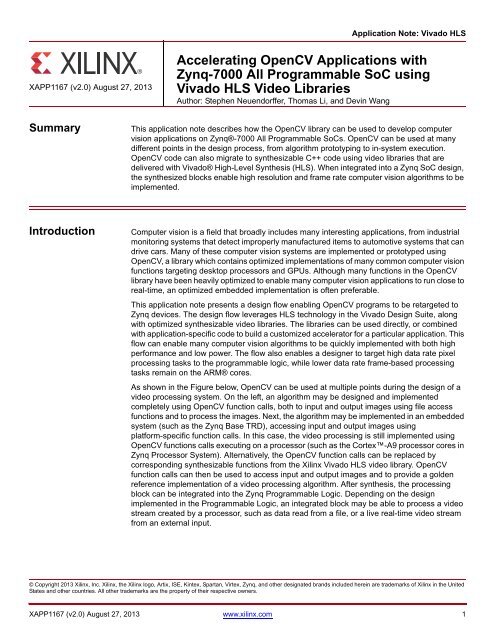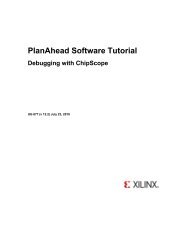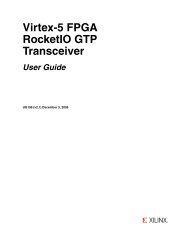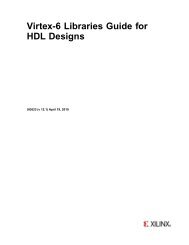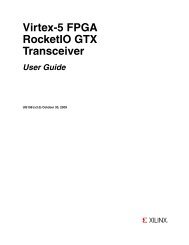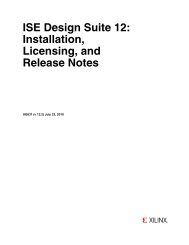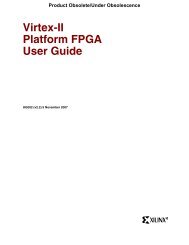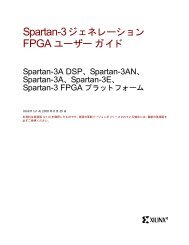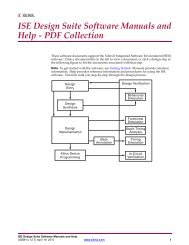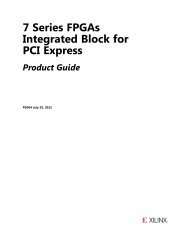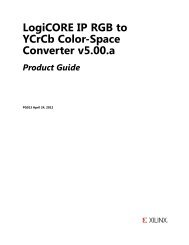XAPP1167
XAPP1167
XAPP1167
- No tags were found...
Create successful ePaper yourself
Turn your PDF publications into a flip-book with our unique Google optimized e-Paper software.
Application Note: Vivado HLS<strong>XAPP1167</strong> (v2.0) August 27, 2013Accelerating OpenCV Applications withZynq-7000 All Programmable SoC usingVivado HLS Video LibrariesAuthor: Stephen Neuendorffer, Thomas Li, and Devin WangSummaryThis application note describes how the OpenCV library can be used to develop computervision applications on Zynq®-7000 All Programmable SoCs. OpenCV can be used at manydifferent points in the design process, from algorithm prototyping to in-system execution.OpenCV code can also migrate to synthesizable C++ code using video libraries that aredelivered with Vivado® High-Level Synthesis (HLS). When integrated into a Zynq SoC design,the synthesized blocks enable high resolution and frame rate computer vision algorithms to beimplemented.IntroductionComputer vision is a field that broadly includes many interesting applications, from industrialmonitoring systems that detect improperly manufactured items to automotive systems that candrive cars. Many of these computer vision systems are implemented or prototyped usingOpenCV, a library which contains optimized implementations of many common computer visionfunctions targeting desktop processors and GPUs. Although many functions in the OpenCVlibrary have been heavily optimized to enable many computer vision applications to run close toreal-time, an optimized embedded implementation is often preferable.This application note presents a design flow enabling OpenCV programs to be retargeted toZynq devices. The design flow leverages HLS technology in the Vivado Design Suite, alongwith optimized synthesizable video libraries. The libraries can be used directly, or combinedwith application-specific code to build a customized accelerator for a particular application. Thisflow can enable many computer vision algorithms to be quickly implemented with both highperformance and low power. The flow also enables a designer to target high data rate pixelprocessing tasks to the programmable logic, while lower data rate frame-based processingtasks remain on the ARM® cores.As shown in the Figure below, OpenCV can be used at multiple points during the design of avideo processing system. On the left, an algorithm may be designed and implementedcompletely using OpenCV function calls, both to input and output images using file accessfunctions and to process the images. Next, the algorithm may be implemented in an embeddedsystem (such as the Zynq Base TRD), accessing input and output images usingplatform-specific function calls. In this case, the video processing is still implemented usingOpenCV functions calls executing on a processor (such as the Cortex-A9 processor cores inZynq Processor System). Alternatively, the OpenCV function calls can be replaced bycorresponding synthesizable functions from the Xilinx Vivado HLS video library. OpenCVfunction calls can then be used to access input and output images and to provide a goldenreference implementation of a video processing algorithm. After synthesis, the processingblock can be integrated into the Zynq Programmable Logic. Depending on the designimplemented in the Programmable Logic, an integrated block may be able to process a videostream created by a processor, such as data read from a file, or a live real-time video streamfrom an external input.© Copyright 2013 Xilinx, Inc. Xilinx, the Xilinx logo, Artix, ISE, Kintex, Spartan, Virtex, Zynq, and other designated brands included herein are trademarks of Xilinx in the UnitedStates and other countries. All other trademarks are the property of their respective owners.<strong>XAPP1167</strong> (v2.0) August 27, 2013 www.xilinx.com 1
Reference DesignX-Ref Target - Figure 1Figure 1:Design FlowThe design flow for this application note generally follows the steps below:1. Develop and execute an OpenCV application on Desktop.2. Recompile and execute the OpenCV application in the Zynq SoC without modification.3. Refactor OpenCV application using I/O functions to encapsulate an accelerator function.4. Replace OpenCV function calls with synthesizable video library function calls inaccelerator function.5. Generate an accelerator and corresponding API from the accelerator function using VivadoHLS.6. Replace calls to the accelerator function with calls to the accelerator API7. Recompile and execute the accelerated applicationReferenceDesignThe reference design files can be downloaded from:https://secure.xilinx.com/webreg/clickthrough.do?cid=323570The reference design matrix is shown in Table 1.Table 1: Reference Design MatrixGeneralDeveloper nameParameterTarget devices (stepping level, ES, production,speed grades)Source code providedSource code formatDesign uses code/IP from existing Xilinxapplication note/reference designs, COREGenerator software, or third partyThomas LiXC7020-1YesCDescriptionYes, based off the Zynq Base TRD applicationnote/reference designs, CORE Generatorsoftware, or third party Simulation<strong>XAPP1167</strong> (v2.0) August 27, 2013 www.xilinx.com 2
Video Processing Libraries in Vivado HLSTable 1: Reference Design MatrixSimulationFunctional simulation performedTiming simulation performedTest bench used for functional and timingsimulationTest bench formatSimulation software/version usedSPICE/IBIS simulationsImplementationYes, in CNoProvidedCg++No implementationSynthesis software tools/version used Vivado 2013.2Implementation software tools/versions used Vivado 2013.2Static timing analysis performedHardware VerificationHardware verifiedParameterHardware platform used for verificationYesYesZC702DescriptionVideoProcessingLibraries inVivado HLSVivado HLS contains a number of video libraries, intended to make it easier for you to build avariety of video processing. These libraries are implemented as synthesizable C++ code androughly correspond to video processing functions and data structures implemented in OpenCV.Many of the video concepts and abstractions are very similar to concepts and abstractions inOpenCV. In particular, many of the functions in the OpenCV imgproc module havecorresponding Vivado HLS library functions.For instance, one of the most central elements in OpenCV is the cv::Mat class, which is usuallyused to represent images in a video processing system. A cv::Mat object is usually declaredsomething like:cv::Mat image(1080, 1920, CV_8UC3);This declares a variable image and initializes it to represent an image with 1080 rows and 1920columns, where each pixel is represented by 3 eight bit unsigned numbers. The synthesizablelibrary contains a corresponding hls::Mat template class that represents a similar concept ina synthesizable way:hls::Mat image(1080, 1920);The resulting object is similar, except the maximum size and format of the image are describedusing template parameters in addition to constructor arguments. This ensures that Vivado HLScan determine the size of memory to be used when processing this image and optimize theresulting circuit for a particular pixel representation. The hls::Mat template class alsosupports dropping the constructor arguments entirely when the actual size of the images beingprocessed is the same as the maximum size:hls::Mat image();Similarly, the OpenCV library provides a mechanism to apply a linear scaling to the value ofeach pixel in an image in the cvScale function. This function might be invoked like:cv::Mat src(1080, 1920, CV_8UC3);cv::Mat dst(1080, 1920, CV_8UC3);<strong>XAPP1167</strong> (v2.0) August 27, 2013 www.xilinx.com 3
Architectures for Video ProcessingcvScale(src, dst, 2.0, 0.0);This function call scales pixels in the input image src by a factor of 2 with no offset andgenerates an output image dst. The corresponding behavior in the synthesizable library isimplemented by calling the hls::Scale template function:hls::Mat src;hls::Mat dst;hls::Scale(src, dst, 2.0, 0.0);1. Notice that although hls::Scale is a template function, the template arguments need notbe specified, since they are inferred from the template arguments in the declaration of srcand dst. The hls::Scale template function does require, however, that the input andoutput images have the same template arguments. A complete list of the supportedfunctions can be found in the Vivado Design Suite User Guide: High-Level Synthesis(UG902) [4].Architecturesfor VideoProcessingVideo Processing Designs in Zynq SoCs commonly follow one of the following two genericarchitectures. In the first architecture, referred to as “direct streaming”, pixel data arrives at theinput pins of the Programmable Logic and is transmitted directly to a video processingcomponent and then directly to a video output. A direct streaming architecture is typically thesimplest and most efficient way to process video, but it requires that the video processingcomponent be able to process frame strictly in real time.X-Ref Target - Figure 2Figure 2:Direct Streaming Architecture for Video ProcessingIn the second architecture, refer to as “frame-buffer streaming”, pixel data is first stored inexternal memory before being processed and stored again in external memory. A video displaycontroller is then required to output the processed video. A frame-buffer streaming architectureallows more decoupling between the video rate and the processing speed of the videocomponent, but it requires enough memory bandwidth to read and write the video frames intoexternal memory.<strong>XAPP1167</strong> (v2.0) August 27, 2013 www.xilinx.com 4
AXI 4 Streaming VideoX-Ref Target - Figure 3Figure 3:Frame-buffer Architecture for Video ProcessingThis application note focuses on the frame-buffer streaming architecture, since it providesmore flexibility and is easier to understand how video processing on the processor cores canbe accelerated. For highly optimized systems, it is relatively straightforward to construct adirect streaming architecture from a frame-buffer streaming architecture.AXI 4 StreamingVideoVideo InterfaceLibraries inVivado HLSVideo Processing Components from Xilinx generally use a common AXI4 Streaming protocol tocommunicate pixel data. This protocol describes each line of video pixels as an AXI4 packet,with the last pixel of each line marked with the TLAST signal asserted. In addition, the start ofthe video frame is indicated by marking the first pixel of the first line with the USER[0] bitasserted. For more information about this protocol see [2].Although the underlying AXI4 Streaming Video protocol does not require constraints on the sizeof lines in an image, most complex video processing computations are greatly simplified whenall of the video lines are the same length. This restriction is almost always satisfied by anydigital video format, except perhaps in a transient which occurs at the beginning of a sequenceof video frames. Dealing with such transients is usually only a problem on the input interface ofa processing block, which needs to correctly handle this transient before transitioning toprocessing continuous rectangular frames. The input interface that receives an AXI4 StreamingVideo protocol can ensure that each video frame consists of exactly ROWS * COLS pixels.Then later blocks in the pipeline can assume that video frames are complete and rectangular.To abstract a programmer from these interfacing issues, Vivado HLS includes a set ofsynthesizable video interface library functions. These functions are shown in the table below.<strong>XAPP1167</strong> (v2.0) August 27, 2013 www.xilinx.com 5
ColorspacesTable 2: Vivado HLS Synthesizable Video FunctionsVideo Library Functionhls::AXIvideo2Mathls::Mat2AXIvideoDescriptionConverts data from an AXI4 videostream representation to hls::Mat format.Converts data stored as hls::Mat formatto an AXI4 video stream.In particular, the AXIvideo2Mat function receives a sequence of images using the AXI4Streaming Video and produces an hls::Mat representation. Similarly, the Mat2AXIvideo functionreceives an hls::Mat representation of a sequence of images and encodes it correctly using theAXI4 Streaming video protocol.These functions don’t determine the image size based on AXI4 video stream, but use theimage size specified in the hls::Mat constructor arguments. In systems designed to process anarbitrary size input image with AXI4 Streaming interfaces, the image size must be determinedexternally to the video library block. In the Zynq Video TRD, the image size processed by theaccelerator is exposed as AXI4-Lite control registers, however the software and the rest of thesystem is only designed to process 1920x1080 resolutions. In more complicated systems, theXilinx Video Timing Controller core [3] could be used to detect the size of a received videosignal.The video libraries also contain the following non-synthesizable video interface libraryfunctions:Table 3: Vivado HLS Non-Synthesizable Video FunctionsVideo Library Functionshls::cvMat2AXIvideohls::IplImage2AXIvideohls::CvMat2AXIvideohls::AXIvideo2cvMathls::AXIvideo2IplImagehls::AXIvideo2CvMatThese functions are commonly used in conjunction with the synthesizable functions toimplement OpenCV-based testbenches.ColorspacesLimitationsOne important thing to observe is that most OpenCV functions are colorspace independent,meaning that they affect each component of a pixel equally. There are, however, a few notableexceptions, where the byte ordering must be specified, and a few cases, where a default byteorder is used. This default byte order (called BGR or BGRA), places the “B” component in thelow-order bits and the R or A component in the high-order bits of a 32-bit word. The AXI4Streaming Video protocol, however, specifies a particular (somewhat unusual) byte order,which is not directly supported by OpenCV. This format places the “G” component in thelow-order bits, followed by the “B” and “R” components.In the Zynq Video TRD, a portion of the design uses the AXI4 Streaming Video byte order, butframes in memory are stored in the more common BGR byte order. As a result, the examplecode in this application note uses the BGR byte order, which enables consistently usingOpenCV as a design testbench.There are several limitations to the current synthesizable library, which may not be otherwiseobvious. The basic limitation is that OpenCV functions cannot be synthesized directly, andmust be replaced by functions from the synthesizable library. This limitation is primarilybecause OpenCV functions typically include dynamic memory allocation, such as during theconstructor of an arbitrarily sized cv::Mat object, which is not synthesizable.<strong>XAPP1167</strong> (v2.0) August 27, 2013 www.xilinx.com 6
Reference DesignsA second limitation is that the hls::Mat datatype used to model images is internallydefined as a stream of pixels, using the hls::stream datatype, rather than as an array ofpixels in external memory. As a result, random access is not supported on images, and thecv::Mat.at() method and cvGet2D() function have no correspondence. Streamingaccess also implies that if an image is processed by more than one function, then it must firstbe duplicated into two streams, such as by using the hls::Duplicate function. Streamingaccess also implies that an area of an image cannot be modified without processing theunmodified pixels around the image.Another limitation relates to datatypes. OpenCV functions typically support either integer orfloating-point datatypes. However, floating point is often more expensive and avoided whentargeting programmable logic. In many cases, Vivado HLS supports replacing float anddouble types with the Vivado HLS fixed point template classes ap_fixed andap_ufixed. Currently this is not uniformly supported in the synthesizable libraries, sincecertain functions (such as hls::Filter2D and hls::ConvertScale) require floating-pointarguments. Additionally, since OpenCV performs floating-point operations, it should not beexpected that the results of the synthesizable library are generally bit-accurate to thecorresponding OpenCV functions, although the intention is generally for the behavior to befunctionally equivalent. In some cases the synthesizable libraries do perform internalfixed-point optimizations to reduce the use of floating-point operations.A final limitation is that interface functions are only provided for AXI4 Streaming Video. Theseinterfaces can be integrated at the system level with the Xilinx Video DMA (VDMA) core andother video processing IP cores, but cannot be directly connected to AXI4 Slave ports or AXI4Master ports. One implication of this is that in designs that require external memory framebuffers (for instance, in order to process several consecutive frames together) the frame buffermust be implemented externally with several VDMA cores managed by the processor.ReferenceDesignsThis app note contains two HLS designs. These designs modify the behavior of the Zynq BaseTargeted Reference Design, replacing the image processing filter in the programmable logicwith a filter generated using Vivado HLS and the Vivado HLS synthesizable libraries. Thegolden model of the synthesizable filter is implemented using OpenCV libraries, enabling thebehavior of the synthesized code to be verified. The designs also modify the Linux application,enabling either an OpenCV implementation of the filter or the synthesizable implementation ofthe filter to be executed on Cortex-A9 cores. In addition, the app note is also packaged withminimal precompiled library binaries of OpenCV for both ARM target and x86 hostarchitectures.The first reference design, named “demo”, contains a simple pipeline of functions shown inFigure 4.X-Ref Target - Figure 4 Figure 4:"Demo" Design Block DiagramIn OpenCV, this application can be implemented using a sequence of library calls, as shown inthe following code example, excerpted from sw/demo/opencv_top.cpp.1:void opencv_image_filter(2: IplImage* src, IplImage* dst) {3: cvSobel(src, dst, 1, 0);4: cvSubS(dst, cvScalar(50,50,50), src);5: cvScale(src, dst, 2, 0);6: cvErode(dst, src);7: cvDilate(src, dst);<strong>XAPP1167</strong> (v2.0) August 27, 2013 www.xilinx.com 7
Reference Designs8:}The synthesizable code also contains a number of #pragma directives that enable ease ofinterfacing. These directives expose the input and output streams as AXI 4 Streaminginterfaces (lines 26-29) and expose the other inputs and the control bus as an AXI 4 Lite Slaveinterface (lines 30-35). In addition, the rows and cols inputs are specified as being stableinputs, since the block is expected to process the same size images repeatedly (lines 36-37).This specification enables additional optimization on these variables, since they need not bepushed through each level of the pipeline. Lastly dataflow mode is selected (line 45), enablingconcurrent execution of the various processing functions, with pixels being streamed from oneblock to another.4:5:void Sobel(RGB_IMAGE& src, RGB_IMAGE& dst, int dx, int dy) {6: // special case of sobel filter.7: assert(dx == 1 && dy == 0);8: const int k_val[3][3] =9: { {-1, 0, 1}, {-2, 0, 2}, {-1, 0, 1}, };10: hls::Window kernel;11: hls::Point_ anchor;12: for (int i = 0; i < 3; i++) {13: #pragma HLS unroll14: for (int j = 0; j < 3; j++) {15: #pragma HLS unroll16: kernel.val[i][j] = k_val[i][j];17: }18: }19: anchor.x = -1;20: anchor.y = -1;21: hls::Filter2D(src, dst, kernel, anchor);22:}23:void image_filter(AXI_STREAM& input, AXI_STREAM& output,24: int rows, int cols) {25: //Create AXI streaming interfaces for the core26: #pragma HLS RESOURCE variable=input core=AXIS27: metadata="-bus_bundle INPUT_STREAM"28: #pragma HLS RESOURCE variable=output core=AXIS29: metadata="-bus_bundle OUTPUT_STREAM"30: #pragma HLS RESOURCE core=AXI_SLAVE variable=rows31: metadata="-bus_bundle CONTROL_BUS"32: #pragma HLS RESOURCE core=AXI_SLAVE variable=cols33: metadata="-bus_bundle CONTROL_BUS"34: #pragma HLS RESOURCE core=AXI_SLAVE variable=return35: metadata="-bus_bundle CONTROL_BUS"36: #pragma HLS INTERFACE ap_stable port=rows37: #pragma HLS INTERFACE ap_stable port=cols38: RGB_IMAGE img_0(rows, cols);39: RGB_IMAGE img_1(rows, cols);40: RGB_IMAGE img_2(rows, cols);41: RGB_IMAGE img_3(rows, cols);42: RGB_IMAGE img_4(rows, cols);43: RGB_IMAGE img_5(rows, cols);44: RGB_PIXEL pix(50, 50, 50);45: #pragma HLS dataflow46: hls::AXIvideo2Mat(input, img_0);47: Sobel(img_0, img_1, 1, 0);48: hls::SubS(img_1, pix, img_2);49: hls::Scale(img_2, img_3, 2, 0);50: hls::Erode(img_3, img_4);51: hls::Dilate(img_4, img_5);52: hls::Mat2AXIvideo(img_5, output);<strong>XAPP1167</strong> (v2.0) August 27, 2013 www.xilinx.com 8
Reference Designs53:}The second reference design, named “fast-corners”, contains a more complex pipeline, shownin Figure 5.X-Ref Target - Figure 5Figure 5:Fast-Corners ApplicationIn OpenCV, this can be implemented using the following code example, excerpted fromsw/fast-corners/opencv_top.cpp.void opencv_image_filter(IplImage* src, IplImage* dst) {IplImage* gray = cvCreateImage( cvGetSize(src), 8, 1 );std::vector keypoints;cv::Mat gray_mat(gray,0);}cvCvtColor( src, gray, CV_BGR2GRAY );cv::FAST( gray_mat, keypoints, 20,true );cvCopy( src,dst);for (int i=0;iwidth,img->height), 8, 1 );4: cvCvtColor( img, gray, CV_BGR2GRAY );5: std::vector keypoints;6: cv::Mat gray_mat(gray,0);7: cv::FAST(gray_mat, keypoints, 20,true );8: int rect=2;9: cvCopy(img,dst);10: for (int i=0; i
Reference Designs12: cvPoint(keypoints[i].pt.x,keypoints[i].pt.y),13: cvPoint(keypoints[i].pt.x+rect,keypoints[i].pt.y+rect),14: cvScalar(255,0,0),1);15: }16: cvReleaseImage( &gray );17:}This code, although written in OpenCV is structured in a way that is amenable to transformationinto synthesizable code. The significant missing functionality is the combination of thecv::FAST function and the GenMask function, which can be implemented using applicationspecific synthesizable code. In particular, this combination generates the keypoints as animage mask, rather than as a dynamically allocated structure. The PrintMask function takessuch as mask and draws on top of the image.The synthesizable version of the fast corners application is shown in the following codeexample, excerpted from fast-corners/top.cpp. The details of the synthesizableimplementation of the FAST algorithm can be found in fast-corners/hls_video_fast.h.1:void image_filter(AXI_STREAM& input, AXI_STREAM& output,2: int rows, int cols) {3: //Create AXI streaming interfaces for the core4: #pragma HLS RESOURCE variable=input core=AXIS5: metadata="-bus_bundle INPUT_STREAM"6: #pragma HLS RESOURCE variable=output core=AXIS7: metadata="-bus_bundle OUTPUT_STREAM"8: #pragma HLS RESOURCE core=AXI_SLAVE variable=rows9: metadata="-bus_bundle CONTROL_BUS"10: #pragma HLS RESOURCE core=AXI_SLAVE variable=cols11: metadata="-bus_bundle CONTROL_BUS"12: #pragma HLS RESOURCE core=AXI_SLAVE variable=return13: metadata="-bus_bundle CONTROL_BUS"14: #pragma HLS interface ap_stable port=rows15: #pragma HLS interface ap_stable port=cols16: hls::Mat _src(rows,cols);17: hls::Mat _dst(rows,cols);18: #pragma HLS dataflow19: hls::AXIvideo2Mat(input, _src);20: hls::Mat src0(rows,cols);21: hls::Mat src1(rows,cols);22: #pragma HLS stream depth=20000 variable=src1.data_stream23: hls::Mat mask(rows,cols);24: hls::Mat dmask(rows,cols);25: hls::Scalar color(255,0,0);26: hls::Duplicate(_src,src0,src1);27: FASTX(src0,mask,20,true);28: hls::Dilate(mask,dmask);29: PaintMask(src1,dmask,_dst,color);30: hls::Mat2AXIvideo(_dst, output);31:}One important thing to observe about this code is the use of the directive in line 22 to set thedepth of one of the streams. In this case, there is a latency of several video lines on the pathfrom Duplicate > FAST > Dilate > PaintMask because of the presence of line buffers. In thiscase, FAST incurs up to 7 lines of latency, Dilate incurs up to 3 lines of latency, which implies aneed of at least: 1920 * (7+3) < 20000 pixels. In addition, the FASTX call in line 27 correspondsto the combination of the cvCvtColor, cv::FAST, and GenMask functions in Figure 6.<strong>XAPP1167</strong> (v2.0) August 27, 2013 www.xilinx.com 10
Source Files and Project DirectoriesSource Filesand ProjectDirectoriesSteps toAccelerate anOpenCVApplicationThe overall structure of the files in the application note mirrors the structure of the Zynq BaseTRD. A prebuilt image for an SD card is provided in sd_image directory, making it easy to trythe design out. This image is slightly modified from the Zynq Base TRD to include aprecompiled version of the OpenCV libraries for ARM in a separate ramdisk image that isloaded at boot time. The device tree has also been modified to include the correct configurationof the generic-uio Linux kernel driver for accessing control registers in the image processingfilter. The sw directory contains two packages for the ‘demo’ application and for the‘fast-corners’ design. To enable easily rebuilding the designs, a Makefile is also provided withthe following targets:• make elf -- build sw (video_library_cmd)• make sim -- build and run csim test• make core -- synthesis and export IP core• make bitstream -- generate bistream (system.bit)• make boot -- generate boot image• make all -- build sw and hw, generate sd_imageRunning ‘make all’ from the Linux command line or the Vivado HLS command prompt underWindows rebuilds the entire design and generates an SD card image that can be run. Newapplications can be made by copying one of the initial sw/ subdirectories, modifying thesource code, and running the appropriate makefile rules. The overall structure of the FPGAdesign is not modified based on the C code, so care must be taken to limit modifications tothose that do not modify the interface of the generated RTL. Alternatively, the interface can bemodified, as long the corresponding changes are made in the FPGA design.In this section we will demonstrate a walkthrough of how to accelerate an OpenCV applicationand test it on board. As an example, the OpenCV application is a simple 2D filter of imageprocessing: erode. By following this walkthrough, one can easily write their OpenCV applicationby replacing the image processing algorithm, and the two reference designs included in thepackage are also applicable to follow this instruction.To achieve this goal, several prerequisites are needed:• Xilinx Zynq-7000 SoC ZC702 Evaluation Kit or Xilinx Zynq-7000 SoC Video and ImagingKit• Monitor with HDMI port or DVI port (HDMI/DVI cable needed), supports 1920x1080resolution, 60 frame rate display• Linux/Windows host• Video library package (ship with this app note)• ARM GNU tools• Vivado System Edition• ISE® Design Suite 14.6 (if using EDK-based design)Most of the following steps will be demonstrated in Linux command line. For Windows, a batchfile that starts the Vivado HLS command prompt with correctly set paths is provided that workswith the same commands. This batch file may need to be modified to reflect the installation pathof the ISE and Vivado tools if they are not installed in the default locations.First, extract the content of the package, use it as home directory:$ export VIDEO_HOME=/path/to/the/extracted/package/root$ cd ${VIDEO_HOME}$ lsboot_image hw opencv_install README.txt sd_image sw<strong>XAPP1167</strong> (v2.0) August 27, 2013 www.xilinx.com 11
Steps to Accelerate an OpenCV ApplicationStep 1. Create new designThe ‘demo’ design includes the basic structure for combinations of image processing functions.To create the new erode design, copy the demo design directory in sw directory:$ cd ${VIDEO_HOME}/sw$ cp –r demo erode$ cd erodeEdit the source file opencv_top.cpp, modify the 5 pipeline functions to just single erodefunction:void opencv_image_filter(IplImage* src, IplImage* dst) {cvErode(src, dst);}Edit the source file top.cpp in the same way:void image_filter(AXI_STREAM& input,AXI_STREAM& output,int rows,int cols) {//Create AXI streaming interfaces for the core#pragma HLS RESOURCE variable=input core=AXISmetadata="-bus_bundle INPUT_STREAM"#pragma HLS RESOURCE variable=output core=AXISmetadata="-bus_bundle OUTPUT_STREAM"#pragma HLS RESOURCE core=AXI_SLAVE variable=rowsmetadata="-bus_bundle CONTROL_BUS"#pragma HLS RESOURCE core=AXI_SLAVE variable=colsmetadata="-bus_bundle CONTROL_BUS"#pragma HLS RESOURCE core=AXI_SLAVE variable=returnmetadata="-bus_bundle CONTROL_BUS"#pragma HLS INTERFACE ap_stable port=rows#pragma HLS INTERFACE ap_stable port=colsRGB_IMAGE img_0(rows, cols);RGB_IMAGE img_1(rows, cols);hls::AXIvideo2Mat(input, img_0);hls::Erode(img_0, img_1);hls::Mat2AXIvideo(img_1, output);}Note: In the new top.cpp, we use the corresponding function in hls namespace to erode an image.Run C simulation to verify the algorithm:$ make simIt will build a test to run hls::Erode to generate an output image to compare with the goldenimage generated by OpenCV function cvErode. See “Test passed!” to verify the two imagesare exactly the same. It is also recommended to view the output images to verify the result oferode.Step 2. Build OpenCV application for ARMTo cross-build ARM applications on host, the ARM GNU tools must be installed. The ARM GNUtools are included with the Xilinx Software Development Kit (SDK). The opencv_install directoryalso includes the precompiled version of OpenCV library for ARM at${VIDEO_HOME}/opencv_install/arm. For more information on using ARM GNU tools orbuilding OpenCV library, please refer to http://opencv.org/.For this design, run the following make rule to build the ARM application:$ make elf<strong>XAPP1167</strong> (v2.0) August 27, 2013 www.xilinx.com 12
Steps to Accelerate an OpenCV ApplicationOnce the build is done, the ARM executable video_library_cmd is in the current directory. TheARM application has options to run OpenCV erode and HLS video library erode on processor.Step 3. Run Vivado HLS to create an IPcoreThis step will use Vivado HLS to synthesize the video library functions, then create an IP corefor the next step. Run the following command to proceed.$ make coreNote: In order to hasten this step, C/RTL co-simulation is omitted here. You can run co-simulation byuncommenting the line with ‘cosim_design’ in run.tcl then re-run Vivado HLS:$ vivado_hls run.tclNote: Running C/RTL co-simulation is always a recommended step in a Vivado HLS design.Step 4. Build new system with the acceleratorThe following command will copy the newly generated IP core to the hw project, run the FPGAimplementation flow to generate a bit stream:$ make bitstreamNext, the boot image of SD card will be generated by the bit stream file with the pre-compiledFSBL executable and the pre-compiled U-boot executable:$ make bootThe boot image is at: ./boot_image/BOOT.bin. At this point, both hardware and software of thenew design are ready to test on board.Note: You can run ‘make all’ in design directory to go through Step 2-4. Once it is done, theready-for-use SD card image will be ready at ./sd_image.Step 5. Test on boardIn directory ${VIDEO_HOME}/sd_image, replace the old ARM executable video_library_cmdand boot image BOOT.bin with the newly generated ones, then copy all the files in sd_image/to SD card.Board setup:• Connect the monitor to the HDMI out port of the ZC702 board using an HDMI or HDMI/DVIcable.• Connect a USB Mini-B cable into the Mini USB port J17 labeled USB UART on the ZC702board and the USB Type-A cable end into an open USB port on the host PC for UARTcommunications.• Connect the power supply to the ZC702 board.• (Optional) Connect the video source which output 1080p60 video to the HDMI in port onFMC_IMAGE_ON board to enable live inputs.• (Optional) Connect the Ethernet port on the ZC702 board to network using an RJ45Ethernet cable.Make sure the switches are set as shown in Figure 6, which allows the ZC702 board to bootfrom the SD card:<strong>XAPP1167</strong> (v2.0) August 27, 2013 www.xilinx.com 13
ConclusionX-Ref Target - Figure 6Figure 6:Switches Setting of SW16 on ZC702 BoardOpen a terminal program (e.g. TeraTerm), set Baud Rate = 115200, Date bits = 8, Parity =None, Stop Bits = 1, and Flow control = None.Insert the SD card which contains sd_image contents to the SD slot on the ZC702 board.Switch the board power on, wait for system brought up login with root/root.Run the application in command line mode:# cd /mnt# ./video_library_cmdConclusionOpenCV is a useful framework for developing computer vision designs. OpenCV applicationscan be also used in embedded systems by recompiling them for the ARM architecture andexecuting them in Zynq devices. Additionally, by leveraging the synthesizable video libraries inVivado HLS, OpenCV applications can be accelerated to process high-definition video inreal-time.Reference 1. www.opencv.org2. AXI Reference Guide (UG761)3. pg016 Video Timing Controller4. Vivado Design Suite User Guide: High-Level Synthesis (UG902)5. Zynq Base TRD (UG925)6. Vivado HLS web page: www.xilinx.com/hlsRevisionHistoryThe following table shows the revision history for this document.Date Version Description of Revisions3/20/13 v1.0 Initial Xilinx release.7/23/13 v2.0 Updated sections to reflect current release.<strong>XAPP1167</strong> (v2.0) August 27, 2013 www.xilinx.com 14


